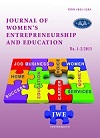Characterising Women in the Informal Sector and Their Struggles to Eke a Living Lessons from Ruwa, Zimbabwe
Main Article Content
Abstract
The paper maps and the struggles and challenges that women in the informal sector face in emerging satellite towns providing a case of Ruwa which is located some 20 kilometres from Harare the capital city of Zimbabwe. The study engaged forty women in informal sector and trading goods and services of various types with the objective of eking a living given the constrained job market dictated upon by the unstable macro-economic environment in urban centres and the country at large. Simple random sampling was adopted to cover street (off-plot) and on-plot activities by the women in the settlement. Besides, non-probability sampling applied with some of the respondents who the research interviewed to let the story of the realities of the women unfold. In their struggle to eke a living the women face and have to brace with challenges including exposure to elements weather (rain, wind, and the sun), service provision, marketing of products, and regulatory forces. Given the macro-economic stability the country has been facing since the year 2000, some of the stakeholders like the town council and private actors in Ruwa have been on a precarious position to offer services. The industry and other employment sectors are operating below capacity. Despite this ‘freeze’ situation, stakeholders can still work together inclusive of the women in the informal sectors to create a forum of dialogue. Through dialogue, it is possible to formulate poverty-reduction strategies that are accommodative of the plight and challenges of the peri-urban women and coin that in local developmental planning. The paper posits that a good governance approach is required in improving the life of the women in the informal sector in Ruwa and elsewhere.
Article Details
Section
Once the manuscript is accepted for publication, authors shall transfer the copyright to the publisher. If the submitted manuscript is not accepted for printing by the journal, the authors shall retain all their rights. The following rights on the manuscript are transferred to the publisher, including any supplementary materials and any parts, extracts or elements of the manuscript:
- the right to reproduce and distribute the manuscript in printed form, including print-on-demand;
- the right to print prepublications, reprints and special editions of the manuscript;
- the right to translate the manuscript into other languages;
- the right to reproduce the manuscript using photomechanical or similar means including, but not limited to photocopy, and the right to distribute these copies;
- the right to reproduce and distribute the manuscript electronically or optically using and all data carriers or storage media, and especially in machine readable/digitalized form on data carriers such as hard drive, CD-ROM, DVD, Blu-ray Disc (BD), Mini Disc, data tapes, and the right to reproduce and distribute the article via these data carriers;
- the right to store the manuscript in databases, including online databases, as well as the right to transmit the manuscript in all technical systems and modes;
- the right to make the manuscript available to the public or to closed user groups on individual demand, for use on monitors or other readers (including e-books), and in printable form for the user, either via the Internet, online service, or via internal or external networks.
Authors reserve the copyright to published articles and have the right to use the article in the same manner like third parties in accordance with the licence Attribution-Non-Commercial-Non-Derivate 4.0 International (CC BY NC ND). Thereby they must quote the basic bibliographic data of the source article published in the journal (authors, article title, journal title, volume, pagination).
